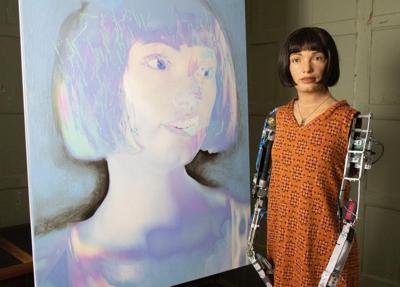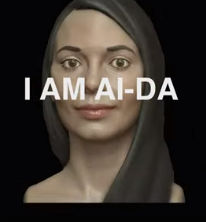| What Is Status Of Art In Our Digital World? |
| Written by David Conrad | |||
| Sunday, 28 March 2021 | |||
|
Art is probably too big a topic, here we focus on artworks that are either generated by artificial rather than human intelligence or that exist in the virtual as opposed to the material world. Two items of news have prompted me to ponder the phenomenon of collecting digital art, look here for more details. First the anouncement that in May there is going to be exhibition of works by Ai-Da and the other that a jpeg, albeit a collage of 5,000 individual jpegs, sold at auction by Christie’s for $69,346,250, the third most expensive auction sale ever of a work by a living artist. We first reported on Ai-Da, named of course after Ada Lovelace, back in 2019 when "she" announced her initial exhibition. This time around the works on show, at London's Design Museum, will include three large self-portraits: Nobody is pretending that Ai-Da is a real woman. She is the "brainchild" of gallery director Aidan Meller, and has been developed by the researcher Lucy Seal, Engineered Arts Ltd together with students from the University of Oxford. Essentially Ai-Da is a computer vision system plus robotic arms, but with a face and body modelled on a young woman. I was certainly scathing in my original report, characterizing the enterprise as a "robot con" in which: the robot artist is personified by its promoters to fool the gullible. My initial reaction was: OK can robots be creative? Tell me what creative means and I might have an answer. Certainly drawing people from "sight" doesn't need creativity, it is a standard image processing or computer vision task. And what is a robot doing with a "bionic" hand!! It's so over the top that it would be funny if it wasn't for the consequences - bringing both art and AI into disrepute. But on reflection it seems there might be a role for Ai-Da in our contemporary world, where we are coming to rely more and more on machine intelligence. I now find myself more in sympathy with the information provided in answer to Who Is Ai-Da on the AI-DA Robot website. If Ai-Da does just one important thing, it would be to get us considering the confusion of human/machine relations, and encouraging us to think more carefully and more slowly about the choices we make for our future – Orwell and Huxley’s messages still ring relevant and we would do well to take heed We have already discovered that people place monetary value on artworks created by artificial intelligence, for example in 2018 we reported that an oil painting created using a GAN and given the title Portrait of Edmond Belamy sold at Christies in New York for $432,500, over forty times its estimate. That at least was a physical canvas - its owner could carry it away and hang it on a wall. Last week a jpeg file entitled Everydays - The First 5000 Days, which, as its title suggests, is a composite of other jpegs and which along with its components can be viewed, and downloaded, for free on Instagram, sold for almost $70 million. Again the sale was made by Christies, which up until this auction had only sold physical works of art. The artist, Mike Winkelmann, aka Beeple said in interview: We sort of value things, it's like if everybody wants it, well, then it has value". While that is certainly true of unique, or rare, or beautiful, physical items, be they artworks or Luis Viutton purses which is the example Winklemann uses, how can it apply to any digital artifact? How can such nebulous (by which I mean existing in the cloud) items have value? How can they be collected or owned? The solution comes from blockchain technology which as well as bringing us with cryptocurrenices now provides "non-fungible tokens" NFTs for short. What is now owned by Metapurse, an Indian-based crypto-exclusive fund that bought the Beeple isn't anything to hang on a wall but instead an intangible digital "certificate" - one that cannot be altered or tampered with and therefore can prove ownership of something that others can access freely but only they can lay absolute claim too. Yes we've heard of artworks not being on show but instead being hoarded for their value rather than their beauty. But isn't this going too far?
More InformationRelated ArticlesAI-Generated Painting Sells For $432,500 - A Deep Misunderstanding Christies To Auction AI-Generated Artwork Google AI Recreates Lost Klimt Artworks To be informed about new articles on I Programmer, sign up for our weekly newsletter, subscribe to the RSS feed and follow us on Twitter, Facebook or Linkedin.
Comments
or email your comment to: comments@i-programmer.info |
|||
| Last Updated ( Tuesday, 24 October 2023 ) |




